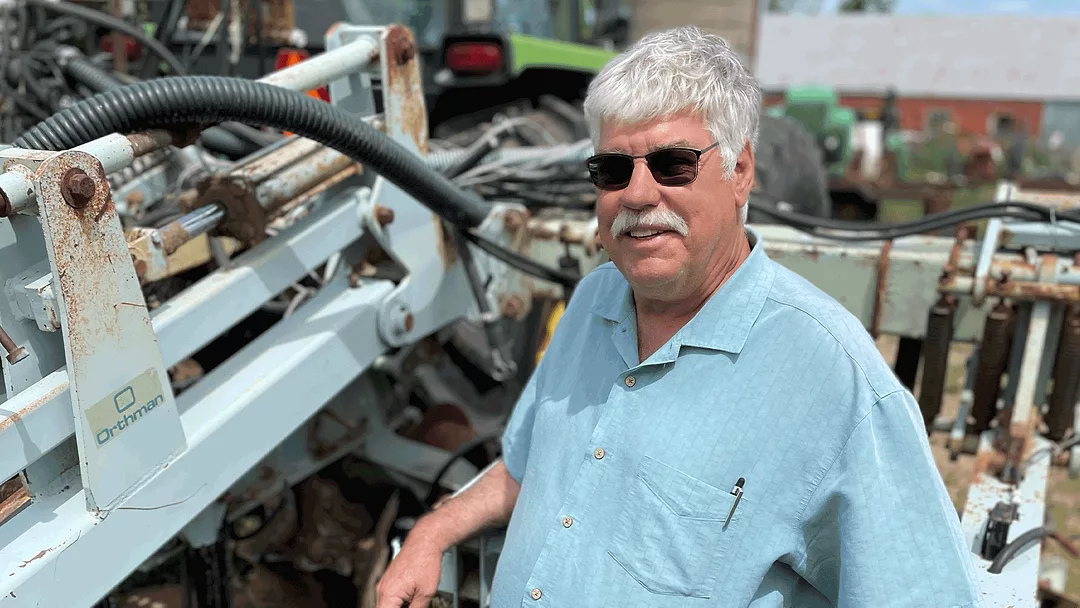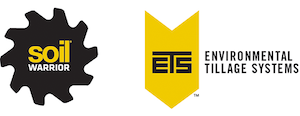On this edition of the Strip-Till Farmer podcast, brought to you by Environmental Tillage Systems, we pay a visit to 2025 Strip-Till Innovator Ray Flickner in Moundridge, Kan.
Flickner takes us around his 1,000-acre corn, soybean and wheat operation for a look at how he’s making strip-till work in relatively challenging conditions.
Flickner details his strip-till system, including the process of split-applying nitrogen (N) with his strip-till rig, planter and irrigation systems, reflects on the challenges of being an early adopter of strip-till in the region and shares agronomic takeaways from on-farrm experimentation.
|
|
The Strip-Till Farmer podcast is brought to you by Environmental Tillage Systems.
SoilWarrior® systems help you defend your land and improve soil quality. With a choice of durable models, features and accessories, your SoilWarrior helps you minimize erosion while creating precise, nutrient-rich zones.
Let us help you defend your land and improve soil quality. Check out SoilWarrior systems online or request a demo today at www.soilwarrior.com.
Full Transcript
Noah Newman:Hey, welcome to the Strip-Till Farmer Podcast. Thanks to our sponsor Environmental Tiller Systems for making this series possible. I'm your host Noah Newman, technology editor. Today we're paying a visit to Ray Flickner's 1000-acre corn, soybean, and wheat farm in Mountain Ridge, Kansas. The 2025 Strip-Till Innovator was an early adopter of strip-till in his area. Our first stop takes us to one of his corn fields, where Ray goes over his crop rotation, and also shares some of the top benefits and challenges of strip-till.
Ray Flickner:Well, the field that we've got here is under a pivot. The concept is that we strip-till before we plant corn, which is what we've done here. Strips were very mellow. Like the advantages of the strip-till. I think it's a great planting technique, plus it also gives you the fertilizer ability, to place the fertilizer in fur, but then you have the advantage of the no disturbance the ground in between the strip.
What we'll do here is we'll harvest the corn this fall. Immediately after corn harvest, I'll plant wheat, winter wheat into the corn stocks without any tillage to speak of. We have an example of that across the road there, what that looks like. Then following wheat harvest in a year, we'll come back and plant soybeans into the wheat stubble. We have a living root growing throughout the year, get three crops out of two years. Basically, everything's got a crop growing, with the exception between the soybeans and the corn planting. The challenge I've had is, I've experimented and I haven't found the answer to that one, as to what kind of a cover crop arrangement should I be using before I plant the corn.
If we dig here in the strips, it's really mellow. We've got good moisture. We're behind our moisture level by about 10, 12 inches for the year, but we did have an inch or rain about 10 days ago. That strip held the moisture and got a really good stand with it in the strip there.
Challenge is trying to make sure the planter stays on the strips. This particular field that was planted here was a 24-row John Deere planter, pull type, and he did a really good job with that one. I've got another field here where I had one of my neighbors plant who had a 16-row three-point mount. You could tell he had a real hard time keeping the thing on guidance with the strips. I had that experience with my eight-row planter with the 4646 tractor. Unless you've got a lot of weight on the front end and a lot of tires, it'll pull you around pretty good. You end up fighting the strips there. That is something one has to worry about when you go to strip-tillage is how do you maintain the planter on top of the strip.
Noah Newman:Do you have any words of advice as to how to do that, how to overcome that challenge?
Ray Flickner:Well, again, I think you got to have the tractor, front end of the tractor weighted right with tires is a key component on that one because it'll pull you around. I am finding, it appears that the pull-type planter stays on maybe better than the mounted planter. But that just came to light this year because previously, the guy, he had an eight-row planter and didn't see to that extent, the problem.
Noah Newman:Don't plant to fast.
Ray Flickner:Don't plant too fast.
Noah Newman:What's the idea planting speed would you say?
Ray Flickner:Well, again, I'm not well-versed in that one. This year, we had a guy that planted at about 11-miles-an-hour with a high speed planter. The corn, I think we were probably okay with. We had some problems on bean seed. I don't know if it was a speed or a combination speed and planter set up that we had some issues with that.
I've always contended five to eight-miles-an-hour is the sweet spot, but I don't have the latest technology with the high speed planter either. We do know that if you plant at high speed with the old technology, you will have a disaster.
Noah Newman:Now, on that same field, Ray is using an autonomous pivot. It's a cutting-edge precision technology tool that can perform up to 300 soil moisture readings per rotation without disturbing the soil. Ray explains how it works.
Ray Flickner:We've used a soil sensor, moisture sensor probes, and so forth. The advantage of this one is that it moves around with the pivot. The other when, where you actually plant the sensor, it'll tell you what the moisture is at that place. When you got everything in the field, you don't know necessarily. This one here, at least gives you a little bit better idea in terms of what the moisture content is. Developed for pivot arrangements. It doesn't work too good for subsurface drips because it doesn't move. We're still negotiating with them on a RAIN 360, whether they want to do that. The concept is tell me what the moisture level is so I know whether I need to water or if I'm watering too much.
Noah Newman:How many years have you used this?
Ray Flickner:Five, I think.
Ryan Flickner:Five years.
Ray Flickner:I think that'd be about right.
Noah Newman:Tell me a little bit about the impact it's had. Do you have a specific story where it's helped you save a crop or help get a crop the moisture it needed?
Ray Flickner:Well, I think what we've found out in the irrigation community ... Again, from here west, the idea was that you couldn't put on too much water. In fact, a lot of the crop scouts, that's the whole deal is keep the water going. I think what we've found out is that we could reduce the amount of irrigation application and still maintain crop, still maintain our yield. In fact, maybe improve the profitability because you don't have the expense of the pumping costs. I think that's what we're evolving to.
I have been pretty stingy on the water usage that I've used because I've got limited water. I've got more acres than I have water. Particularly in July and August in this part of the country, when it really gets dry. You start things up and you try to get it around. It has proven the concept that, yeah, you can get by with less water application.
Noah Newman:Speaking of less water application, a recent Kansas State study revealed the Flickner's are using 40% less water than the county average. Now, a big reason for that is they're subsurface drip irrigation system, which was installed in 2001. It used buried drip tape installed about 18-inches below the soil surface to deliver water directly to the root zone throughout the growing season. Ray also uses it to inject fertilizer when needed. Let's check it out.
Ray Flickner:The original well drilled on the Flickner Operation in 1955, we're still using that well for production purposes. I do have a liner in it because it's got an old steel casing and I'm worried about the casing giving in at some point, but we are producing out of the same hole. Yeah, this goes back to the Flickner family a long time.
This drip tape then was installed in 2001, so we're going hit our 25th year this year. Configuration with that one is you've got the pumping units, and then you filter before it goes to the field. That's this configuration here. Then you have the ability to inject fertilizer. Typically, that's UAN. I can do that without any problem. Phosphorus with the bicarb load in the water is a problem, you got to watch that and stay away from that one because it can plug the emitters up.
It's an automated system, just like an urban house with sprinkler systems watering their yard, it goes from zone to zone. Same arrangement with this one here. You've got a control box here and we've got all different zones. You plug in which zones and how long you want it to water, and it basically becomes an automatic watering system assuming everything goes right.
Noah Newman:25 years coming up on using this technology. Explain your motivation for implementing it and how it's changed things for you guys.
Ray Flickner:Well, again, we did gated pipe for a long time. We had a fair amount of topography variation, and so forth. Then when my father's health was failing and I was still traveling, I had to make a decision as to, "Okay, how are we going to water the deal?" It became a labor issue, didn't have the labor. I had seen the concept in Arizona and California being used, decided that there was some application here. That's what was the driving force is.
You're able to water the whole property. A pivot didn't work out too well because we had the creek and farmstead obstacles in the way, and so forth. We were going to end up with an awful lot of wasted acres that wouldn't be able to be watered. Drip was the answer that we could water every acre on the farm that had been permitted. It was a very expensive proposition, but one that glad we did. From a labor savings, it's good. From a water efficiency standpoint, there's some real advantages. Fertility. Like I say, the biggest downfall I see with it is the leak problem which you have, which is rodent-dependent. Also, the inability to germinate a crop. If you don't have moisture planting, you can't germinate it up.
Noah Newman:As we were talking about it, you have to make sure that the strips, when you're planting, you're not planting right on top of the drip feed, right?
Ray Flickner:Well, the key concept is, yeah, since you're 60-inches between drip tape on a 30-inch planting, you want every row basically 15-inches. The middle rows then would not have the tape at all. The concept is to try to match the distance from the plant to the drip tape and make sure that that's constant. If the crop is planted right over the drip tape, that means the next row over is 30-inches away from water. That's not a good thing that you want to see.
The idea is, okay, when we pull the strips because I want the planter to run on the strips, so let's strip-till such that we basically have that 15-inches between dripper tape and the row that will be planted. With the idea then that, when we come back and plant it, we're going to plant on top of the strip.
Noah Newman:About how much less water are you using compared to other people in your area because of the drip tape?
Ray Flickner:Well, all said and done ... And again, we've got mobile drip on a pivot and some things like that. The university K State has done a study, we're using 40% less water than the county average, which is huge. We're over-allocated with the aquifer, we have seen a decline in the aquifer since 1970. But they do think that, if we could cut water usage by five to seven percent that we would be sustainable. Well, if you have a 40% savings and everybody else is using that much more, if they'd even cut that in half, that would have major implications for the aquifer. Which is a lot different than the Ogallala issue out in Western Kansas. Everybody hears about the Ogallala. We're not in the Ogallala, we're in the high plains aquifer of which the Ogallala is part of. But our issues here are a lot different than the Ogallala in Western Kansas.
Noah Newman:Just a couple years after installing that subsurface drip irrigation, Ray bought an eight-row Orthman one-tripper. Ray and his son Ryan tell us about some of the unique features on the toolbar, which they used for almost two decades.
Ray Flickner:This was my original strip-till machine, bought in '05 I think, something like that. As I said, I had borrowed or had rented a neighbor's hay row machine the first year, and then decided to go ahead and make the purchase. Found this as a used machine on the lot. Been a lot of hours pulling this thing around. It's worse for the wear, but served its purpose well.
Ryan Flickner:Originally was a three-point mount. The original tractor that was on didn't quite have the horsepower and the oomph to lift it, so we added on the wheels on the backend, mainly because the under-horsepower tractor. And then when we got the 4960 here, you have plenty of horsepower. But ultimately, figured out pulling the top on the three-point, align with the float, and then adjust the back tires allows it to pitch and you actually had a lot better seedbed where you could adjust depth. But then also, the tillage mechanism left a lot better strip-till when we learned that out. A lot of trial and error acreage.
Ray Flickner:Truly, it was going to be a one-tripper. I retrofitted it and I was spraying herbicide all in one pass. I'd drop the fertilizer, and then we were spraying the herbicide right behind the strips trying to do one trip through the field.
Noah Newman:It's pretty unique. I've never seen that before I don't think.
Ray Flickner:Well, we do crazy things around here.
Ryan Flickner:Again, multiple fertilizers. A lot of 10-34. We had multiple products to 10-34. We put some 32 UAN through it as well. We put ATS or AMF.
Ray Flickner:We put everything through it. I put everything through it. It's all been through it. But again, that's what I like about strip-till is the ability to put the fertilizer in strip and then plant on top of that. That's really I think probably the major advantage that I see with the strip-till is the ability to put the fertilizer in-ground and keep it off the surface.
Noah Newman:Now that you're not using this strip-till machine, tell us how you're doing strip-till now, you're hiring someone.
Ray Flickner:I've got a neighbor that's got a Kuhn Gladiator 12-row that's doing it for me. Again, putting fertilizer down, all the things. Trying to become more efficient and I'm getting lazier all the time.
Noah Newman:You're making your strips in December. You hear either fall versus spring, but you're bordering on winter.
Ray Flickner:Well, again, I could do it early maybe. Now, as I said, in this country with the moisture, you never know. No two years are the same. But the spring can get rather wet and with the soil type, wet soil, you end up with a whole bunch of issues that come along with that one. The November deal really is a function of I got corn harvest going on in September, October. I got bean harvest going on in October. Some years, we come back and finish up corn after bean harvest.
Ryan Flickner:We grill our wheat, end of October.
Ray Flickner:You're grilling wheat. You get done with all the seeding process and then you say, "Okay, well, now I can get to the strip-till." Again, the other thing that I'm trying to do and I've had good luck with that is to put the burn down herbicide with the applicator prior to strip-tilling so I don't have to worry about running over strips with the spray rig. By the time you get it sprayed and everything else, it works better that way.
Noah Newman:All right, it's a pretty quick timeout. Here's a message about Environmental Tillage Systems' Soil Warriors. Soil Warrior Systems help you defend your land and improve soil quality. With a choice of durable models, features, and accessories, your Soil Warrior helps you minimize erosion while creating precise nutrient-rich zones. Let us help you defend your land and improve soil quality. Check out Soil Warrior Systems online or request a demo today at soilwarrior.com. That's soilwarrior.com. Now, back to the conversation.
Ray captured the 2025 Strip-Till Innovator Award for several reasons, one of which is the creation of the Flickner Innovation Farm, launched a few years ago as a testing ground for new farming technology and conservation practices. The Flickners partnered, pun intended, with local John Deere dealer PrairieLand Partners to test See and Spray, ExactShot, and predictive groundspeed automation throughout the 2025 growing season. Product innovation specialist Bryan Berggren joins us now to give us a rundown on the trial.
Bryan Berggren:Hey, Bergy here with PrairieLand Partners. Today we're out at Flickner Innovation Farm. We're showing you a little bit of what we've done, or what we're trying to prove this year. We're putting all our technology in place. To start off with, we planted this with an exact merge planter and we used ExactShot. What that does, that's a fertilizer system that you can place the fertilizer either just a shot on the seed, you can move it off the seed, in between the seed. What we did here, we did four different trials, four different strips. We did ExactShot with our normal six gallon to the acre rate. We did streaming side beside. Then we put in some Capture LFR, which is an insecticide, and we did the same two treatments with that.
Then we came back in here, just probably a week ago today, with our See and Spray machine and we did our post-residual, along with some Roundup and Laudis here in the See and Spray part. We sprayed, out of the See and Spray side, we sprayed roughly 60% of this field. As a whole, last year ... I'm going to back up just a teeny bit.
Within PrairieLand, two years ago, we had four machines. Last year, we had 20 machines. Of those 20 machines, they averaged, as a whole, 60% as a whole. This year, the See and Spray is getting quite a bit of traction. This year, we actually have 50 machines in our AOR here in Kansas. Which is Central Kansas to the east, excluding the very northeast.
Noah Newman:So you'll come out here and you'll run the See and Spray system for people then? Or does any farmer run it on their own?
Bryan Berggren:Yeah, sure. Like I say, out of all of those machines, most of them are farmer-owned. We have five Ultimates, just like the machine you see here, that are with commercial applicators. They're gaining a lot of traction, they've had the request. Last year, our biggest one, they had a lot of traction with it, did good. A matter of fact, they were probably the number one as far as chemical savings. Out of the whole group, they averaged just a little over 60%, I think 60% or something like that. They did very good.
Noah Newman:This partnership with the Flickners, to be able to come out here and run all this new technology, can you just tell us a little bit about the value of that, and everything you're able to learn from everything out here?
Bryan Berggren:You bet. These guys have been gracious enough to work with us. They do a lot of hiring, custom hiring their farming done. With that, that allows us to be able to come here. They also partner with K State, which we are doing here. The idea here is to grab some data that's not us generated, but K State is going to come down and help us do the research. They're going to dig and look at our root masses. Across the road, we're doing another trial with the See and Spray only. We're trying to assess plant health, that's something that's really, really hard to prove. But we're going to try to do a full season plant health assessment on the See and Spray within the soybeans. We also have a field south of here that we're doing the same thing with cotton. Cotton, those guys go over those fields 12 times, and they're always spraying some sort of a Liberty or something like that, to keep the fields clean because weeds and a cotton stripper do not mix.
Noah Newman:What have you learned so far about the See and Spray? I guess how, mainstream for lack of a better word, would you see this technology being in the next few years?
Bryan Berggren:They changed, John Deere changed their strategy as far as the pricing structure. Right now, this season and moving forward, you're only getting charged for the savings, which means you're getting charged for the acres it does not spray. That takes some of this equation out. There's such a thing as fallback mode when the boom gets too high or you go too fast, it starts spraying solid in that section. What that does is that gets the price way down to an acceptable price point. People want this technology, they want to be able to use this to, number one, save chemical or money on chemical, and all of that to be responsible just a little bit with what they're doing with the land. Nobody wants to spray chemical all the time. This is really, I would say, gaining a lot of traction in the industry as whole is moving this direction. They're coming fast and there's lots of other companies developing this type of technology.
I would say personally, I was very skeptical from the beginning because I've run the sprayer for 20, 30 years, and worked for some commercial applicators. It never ceases to amaze me how sensitive it is. It sees more than we can see actually with our own eyes, and even moving at 12 to 15-miles-an-hour through the field, recognizing a crop versus a weed. It's unbelievable. Really, really impressive.
Noah Newman:The Flickners will usually host a Field Day every other summer to share key takeaways at the Flickner Innovation Farm and give farmers an up-close look at precision technology in action, like this 360 RAIN autonomous irrigation system. The Flickners became the first farmers in Kansas to use it.
Ray Flickner:The rig will operate, I think they say basically at 250 gallons a minute is about all you can operate the system with. If you've got limited water availability, there is some real advantages. Then the fact, if you can plant it and you can water it in odd-shaped fields, and so forth.
The challenge I think we have with this rig and where we're at, versus Illinois or Wisconsin, is you guys back there, you're always 10 days away from a drought, but it seems like it always rain about every seven days. Well, we're not that lucky here. I think back there, they use this as a supplement for that 10-day period or that two-week period where it didn't rain that you can do that. Well, I need to use this basically all season to get it watered. There's some concerns about can you cover the territory you need to cover and get the water applied. We're still trying to figure that one out, get some of the bugs out. I think the concept makes a lot of sense.
But yeah, there's been a number of issues. We had the hose break apart once or twice, the weld didn't hold. Right now, I'm having a problem with an engine that doesn't want to run. It surges all the time and we're trying to figure out what's going on with that one. It's not without its challenges.
Noah Newman:Can you explain how it works? I know I've read about it.
Ray Flickner:Well, you got a 26-horsepower diesel engine on the front, which is basically running a generator because the wheel drives are electric. It does have a little bit of a hydraulic deal because of the steering mechanism and some of the stuff up on the back, in terms of opening up and closing certain lines. It moves through the field and as it moves through the field, it will uncoil the hose which is hooked up to the pumping unit. As it goes forward, the outside three drops on both sides will drop water. When it gets to the end of the field, it will back up following the same place it went forward, and then the three inside or the six inside drops will drop water.
The concept with that one is that way the tire wheels stay on dry ground. Because when you fill that thing full of water with 3000-foot of three-inch hose, it weighs a lot. It will track up, it'll make ruts. Now, it won't get stuck, but it'll make ruts. Well, the problem with ruts is when it comes back the next time, those ruts aren't straight in terms of the guidance system, so it messes the guidance system up and it shuts everything off. It is not a mud machine. You don't want to run it in mud. But yeah, as it goes one way, it rolls out the hose. When it comes back, it rolls the hose up. It does not drag the hose. It lays it out and picks it up at the same time.
The other thing that I think is of real interest that I see real application is in the livestock industry. Dairies and hog operations that have lagoons that need to be dewatered during a season, this would work very well for that situation. You don't have any little nozzles, little emitters to worry about plugging up. It's pretty well an open flow system. A lot of application in the livestock industry.
Noah Newman:You used it to apply nutrients, too?
Ray Flickner:We applied nitrogen last year, some ATS. Yeah, we'll apply a number of different options. In fact, I see no reason why we can't apply 10-34 even with our water because there's nothing that's going to plug up. We're going to try that this year.
Last year was just how do you make the machine work and how does this all happen. Then it's also, there's an application, I can manage this from wherever I'm at. I don't have to even be in the state and we can start it up and stop it. Or, Ryan. It's got the tramlines laid out for it to follow. When it works, it's great. There have been a few complications.
Noah Newman:Yeah, that's pretty expected with new technology. But you're pretty encouraged with what this can do for your efficiency?
Ray Flickner:Right, right. Again, for developing a water permit. Now, I talked about previously having four of the senior water rights in the county, in the area. This water right here is a very junior water right. In fact, I'm in the process of trying to get it perfected. I got to apply water, that's the interesting thing from the state. They want you to conserve water, but you got a five-year period to perfect it. They'll only give you the amount of water that you apply during that five year period, the maximum you apply. There's no incentive to conserve water during the perfection period. You want to use everything you can up to your application amount, your approved amount, otherwise you'll be shortchanged when it gets perfected. We're going to work on trying to get a bunch of water through the system from a perfection standpoint.
Noah Newman:All right. That'll wrap up our tour of the Flickner Farm. Big thanks to Ray and Ryan for taking the time to drive us around. Looking forward to learning more about Ray's system at the 2025 National Strip-Tillage Conference July 31st in Iowa City. Hope to see you there. Striptillconference.com for more information.
Once again, thanks to Environmental Tillage Systems for making this podcast series possible. Thanks so much for tuning in to the Strip-Till Farmer Podcast. We'll see you next time. Have a great day.













